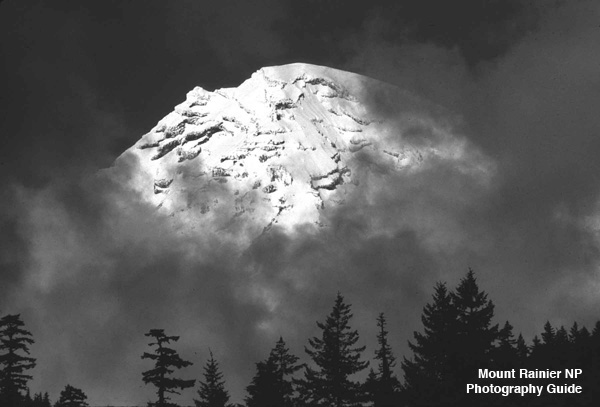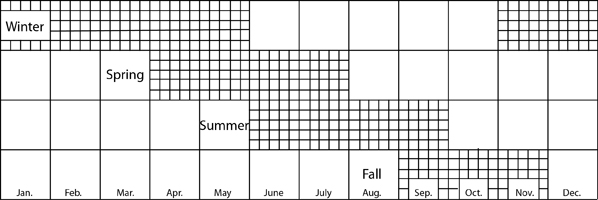

The Seasons in Mt. Rainier NP
MPG V2.8, January 2013
Season Guides
(Get guide for each season.)
Introduction
Mt. Rainier NP has four distinct seasons, varying in lengths, winter being the longest and lasting half the year in most years, and varying in location and elevation in the NP. The other seasons fit into the rest of the year, from longer in lower elevations to very short in the upper elevations.
When scheduling your visit, it's the old adage, "timing is everything", which is why the visitors' guides, both here and elsewhere in books and on-line, advise you to plan and prepare for the whole range of weather, especially the worst, and be flexible with your plans when the weather and conditions change.
Overview
The climate for the NP can be presented in an information charts and graphs for the months of the seasons, for the months by elevation, and a general description of the seasons with a general guide to the snowpack-snowmelt and wildflower seasons. The months overlap depending on the year as the seasons change from one to another during the month or start earlier or end later in a month.
Seasons
Generally in the NP winter last from November through April at the lower elevations where lasts through May and June in the mid-upper elevations, ending in the upper elevations in July. This is when spring starts which is generally short when summer starts in June and progresses through August and into September, after which fall arrives and lasts until November when winter resume it's dominant role in the NP.
General Seasons
This is presented in the following chart which shows the season in months with the overlap. You must remember, however, all of this is the general pattern for the year, as any individual years will vary as we have seen with the variation in the annual snowpack and snowmelt over the years in the NP, such as 2011 and 2015.
In 2011 the high snowpack and late snowmelt lasted well into August with the last of the mid-upper elevation snow melting the week before the Labor Day holiday. In 2015 there was a record low snowpack and early snowmelt where the wildflower season started in mid Jue and last until mid August with the record number of days with high temperatures and infrequent and low rainfall between Memorial Day and Labor Day holidays.
General Seasons Chart

Seasons by Elevation
To present it by elevation, the general seasons in the NP varys by elevatioins, the low elevations, below 4,000 feet, the mid elevations, 4,000 to 6,000 feet and the upper elevations, above 6,000 feet, which is presented with the chart below. Again overlaps exist between months and over elevations depending on location in the NP.
Seasons by Elevation Chart
< 4,000 ft
4,000-6,000 ft
> 6,000 ft
Description of Seasons
You can get more details of the seasons in the NP, listed at the top or bottom of this Web page, but I'll give a brief description starting with winter.
Winter.-- Winter is defined by one thing, snow, with both the early snowstorms in October, which occur occasionally, and the initial seasonal snow in November in the upper elevations and December in the mid and even the lower elevations in some years.
October snow rarely last more than a few days except in the higher elevations on Mount Rainier itself. November is the dynamic month where snow may last into December in the mid elevations, but also may melt in rain-on-snow storm events which bring devastating floods like those we saw in 2006 and 2008.
Once the seasonal snow is present in the NP, then winter is determined by the accumulation of snow through the winter until April or May when it reaches its peak snowpack in the mid-upper elevations, but it is the March-April weather, namely the temperatures, which determines the extent of the snow at the low-to-mid elevations.
All of this is for a normal year. Extreme low snowfall and snowpack years extends more fall-like weather into December and starts spring weather and temperatures earlier in the following March. High snowfall and snowpack years will do the opposite, start winter earlier in October-November and extend it into May-June, and in a rare year into July-August.
Spring.-- The transition from winter to spring is often hard to see and tell when it starts unless you pay attention, but the signs are there, usually not long after the warmer temperatures arrives and the snow clears from the low-mid elevations.
Most visitors don't usually see it until May, especially the Memorial Day holiday weekend, when the visitors season more or less officially begins despite snow throughout the NP in the mid-upper elevations. The snow free areas are more evident in May and into June in normal years (earlier in low snow years and later in high snow years) in the mid elevations where many of the trailheads and visitor stops are located.
Spring is usually the shortest season as once the snow clears and the weather improves with warmer temperatures the plants and trees quickly begin their new growth and low elevations plants reach their seasonal growth into the early summer.
Summer.-- While summer in the NP really starts on the Independence Day (July 4th) holiday and adjacent weekends, the visitor seasons runs from the Memorial Day holiday through the Labor Day holiday weekends, but it is the period from mid-July to mid-September which is the period of good weather throughout the NP.
It is the period of the wildflowers, the nice long hiking days, and the beautiful landscapes and scenes. It also the period the pesky insects which thrive in the short season from early-mid July to mid-late August and the first cold night temperatures (< 35 deg.) in the mid elevations when hiking from then through September is the best, especially after the Labor Day weekend with fewer visitors and hikers.
It is the period from mid-July to late August that defines summer in the NP, but the weather can be very dynamic with occasional cooler temperatures and rain. That said, it is when you see the whole beauty of Mount Rainier and the entire NP, especially the meadows and alpine areas.
The period is extended earlier during low snowpack years when and where the snow clears in May at all but the upper elevations instead of the normal June and into July in the higher elevations. The period is shorter when the snowpack, like 2011, was a near record and the snowmelt extended into August with the wildflower season delay in all areas until August and into September in the higher elevations.
The transition each year from summer into fall is always variable with the year, as some years the summer is over early in September and some years extends into October with an Indian summer and a mild early fall, but fall always comes to the NP.
Fall.-- Fall officially starts in early September when the NPS starts the transition of the National Park for winter. This usually happens through October and by the beginning of November the NP is in fully winter operations waiting the arrival of the seasonal snow.
As noted in the description of winter, fall can be short with October snowstorms, and while the snow doesn't persists, the weather does and the NP is in full fall mode, and while it can extend into December in low snowfall years, from October to the start of seasonal snow, the NP is fall with colder temperatures with either clear, sunny days or rain or snowstorms.
This is the period for the hardy, experienced hiker, much like the spring hiker who has experience with the spring snow on the trail and with the dynamic weather. In between those periods the NP resorts to what it does best, hibernate through the winter, waiting for the next year of summer.
Wildflower Season
Where the summer seasons is clearly evident is in two ways, the obvious weather and the most photographic interests of photographers, wildflowers. The former is self-descriptive as Mt. Rainier makes its own weather and you adjust and adapt for your visit and hikes, and with your photography.
The wildflower season, however, is critical and depends entirely on the weather, the winter snowpack, the spring snowmelt and the summer warmth and sunshine. In normal years, the wildflowers bloom right on schedule, as noted in the following table.
Seasons by Elevation Chart
< 4,000 ft
4,000-6,000 ft
> 6,000 ft
Again, the timing is totally dependent on the snowmelt and early summer weather along with continued mild to warm summer weather and the normal sunshine.
Photography
For your photography, it's hard to forecast when the actual seasons in the NP more than a general forecast with a probability. It doesn't say anthing more than an idea because there have been years which have defied the normal and the forecasts. So what does it mean for timing your trip for the best wildflowers?
The answer is the obvious, wait for the news the bloom have started and then get there and hope it's true. This is because the promenient wildflower meadows are between 3,800-6,400 feet, meaning in the upper-low elevation and the low-upper elevation zones with most in the mid-elevation zone, and that's the zone the hardest to forecast the snowmelt and the wildflower season.
Resources
There aren't many descriptions of the seasons in Mt. Rainier NP specifically focusing on the climate and weather beyond a general description, but if I find some, they'll be listed below.
Please use the contact link to send e-mail.